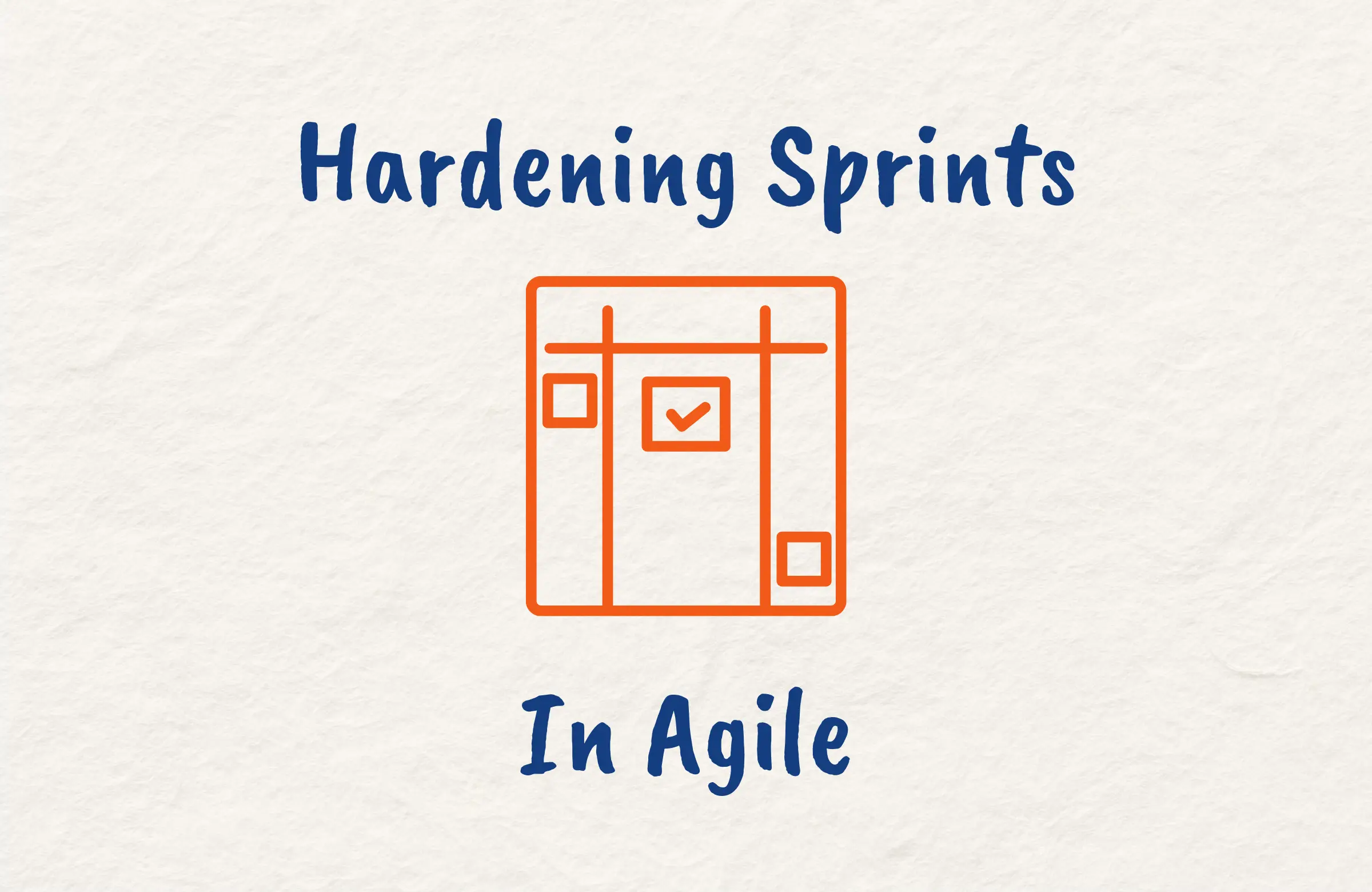Agile methodologies use Sprints to enable the continuous delivery of working software. Features are developed in short Sprints and released according to the release plan for incremental development.
But what happens if quality issues creep in, jeopardizing release plans? This is where hardening Sprints come in.
These additional Sprints focus on stabilizing and testing code to meet quality standards when used strategically. However, they have a bad reputation when it comes to Scrum but it’s important to note that Scrum is not the only Agile method.
In this article, we’ll explore what hardening Sprints are all about, and how to leverage them to complement regular Agile development, allowing your team to deliver high-quality, shippable increments.
We’ll also look into the effects of hardening Sprints and whether they are actually a necessity in Agile or constitute an anti-pattern, especially for the Scrum framework.
What is a Hardening Sprint in Agile?
A hardening Sprint is a special Sprint focused on strengthening the quality of the software product increment developed during regular Agile Sprints.
While Agile methodologies emphasize working software delivered in short iterations, the focus on speed can sometimes come at the cost of quality.
The goal of continuous integration is to release quality code frequently, but factors like technical debt, inadequate testing, and unstable code can make a release risky.
This is where hardening Sprints come in – to supplement regular development Sprints with activities aimed at stabilizing the system, clearing out defects, and preparing it for production deployment.
You can think of hardening Sprints as a final quality check to improve the shippable state of the product before it gets into customers’ hands.

Purpose of a Hardening Sprint
The main purpose of a hardening Sprint is to increase the quality and stability of the software before its release to end users.
While Agile teams try to produce potentially shippable increments in each Sprint, the reality is that quality issues, technical debt, and inadequate testing can make the software increment unreliable for real-world usage.
A hardening Sprint provides a buffer to stabilize the system. Its activities focus on finishing incomplete development and pending test tasks, clearing out defects, and overall preparation of the product for deployment.
Hardening sprints allow you to test the system more thoroughly by focusing on aspects you may not test extensively during regular Sprints such as end-to-end flows, integration points, non-functional testing, and performance.
The goal is to fix the remaining bugs and get customer feedback to ensure the increment meets release criteria.

Hardening Sprint Activities
Hardening Sprints should focus on quality-oriented activities that prepare the product for release.
Here are some key activities:
Completing Pending Tasks
Complete leftover tasks like finalizing documentation, enhancing error handling, code cleanups, config reviews, etc. to clear the checklist before release.
Verification Testing
Perform rigorous testing to verify all requirements are fulfilled. Include unit, integration, system, end-to-end, usability testing, and leverage automation to execute large test suites efficiently.
Non-Functional Testing
Do load, performance, reliability, and security testing to ensure the system can handle real-world usage, and tune issues like slow response times.
Bug Fixing
Fix critical and high-priority bugs, and re-test when done to confirm that the fixes worked.
Release Planning
Plan deployment tasks, roll out sequence, and smoke tests. Then draft communications and train support teams.
Run Simulations
Test on a replica production environment with real-world configurations and data load, then observe the system behavior and identify tuning opportunities.
Optimization
Improve inefficient processes, bottlenecks in integration points, queries, etc. to enhance overall performance.
Technical Debt Reduction
Analyze issues flagged by static code analysis tools. Improve code quality by refactoring, adding comments, etc., and reduce the technical debt accrued over Sprints.
Regression Testing
Perform extensive regression testing to check for unintended side-effects from new code and bug fixes, and use automation to re-run test suites efficiently.

When to Use Hardening Sprints
Knowing the right time to schedule a hardening Sprint is key to maximizing its effectiveness for your team.
Though there are no definitive rules, here are some common scenarios that call for a hardening Sprint:
Before Major Releases
Schedule hardening sprints right before major feature releases or product version launches.
Use it to stabilize the increment, run end-to-end tests, and fix critical defects to ensure that the key features are quality assured before the release.
Significant Codebase Changes
When major architectural changes, migrations, integrations, etc. are done, plan a hardening sprint. Use it to improve performance, check for regressions, and verify overall quality.
Quality Issues Persist
If your team is unable to meet quality standards within regular Sprints, a hardening Sprint can provide the focus required to address this. Prioritize fixing defects and writing automated tests to improve quality.
New Team Onboarding
For new teams, hardening Sprints help to build familiarity with the codebase and focus on the product getting to a shippable state.
Transitioning Cadences
When transitioning from longer iterations to shorter Sprints, hardening Sprints can act as a bridge to ensure quality.
Benefits of Hardening Sprints
Hardening sprints can provide several advantages when used strategically. Some of these benefits include:
Improved Quality
By dedicating Sprints to stabilizing and testing the product, you allow sufficient time to meet quality standards instead of rushing for release resulting in a higher quality increment.
End-to-End Validation
Hardening sprints facilitate end-to-end testing of the integrated system, thus building confidence that the software will work as expected in production.
Risk Reduction
Comprehensive testing, fixing critical bugs, and trial deployments during the hardening sprint greatly reduce risks associated with releasing low-quality software.
Better Release Planning
The buffer provided by hardening sprints gives adequate time for release planning activities like documentation, training, deployment prep, etc.
Technical Debt Reduction
Focusing on code quality improvement, refactoring, test coverage, etc. helps reduce technical debt that accumulates over multiple Sprints.
Knowledge Sharing
Hardening Sprints allow team members to work closely together, enhancing collaboration and knowledge sharing.

Is it Normal to Have a Hardening Sprint in Agile?
While the need for hardening Sprints indicates some inefficiencies in the team’s Agile practices, they are commonly utilized by many teams in the real world.
Hardening Sprints provide the focus required to stabilize the product and meet quality goals prior to release helping to bridge the gap between the faster pace of Agile development and the need for comprehensive pre-release activities.
However, if your team frequently depends on hardening Sprints, it’s a sign that quality issues are creeping in during regular Sprints.
Reflect on how to improve your practices. Are estimates realistic? Is technical debt addressed? Is testing automated enough? Are quality standards clearly defined?
The goal should be to build a sustainable cadence that minimizes the need for hardening Sprints through early and continuous emphasis on quality and testing.
With improved engineering practices, your team can develop releasable increments within regular Sprints.

Is Hardening Sprint in Scrum an Anti-Pattern?
The need for hardening Sprints is sometimes seen as an anti-pattern in Scrum because it indicates the team failed to produce a releasable increment within the regular Sprints.
Scrum framework expects teams to complete all necessary work to meet the quality bar within the standard Sprint duration.
However, in complex projects, hardening Sprints may be necessitated despite diligent Scrum practices due to practical constraints. Hence hardening Sprints can’t just be automatically categorized as a Scrum anti-pattern.
Valid reasons like technical debt, legacy systems, inadequate test automation, inexperienced team members, complex infrastructure needs, etc. could make it infeasible to complete sufficient testing and stabilization activities within a single Sprint.
Hardening Sprints also provide advantages like more extensive performance testing, user acceptance validation, and trial deployments that are hard to accomplish in short Sprints.
Used judiciously, they enable teams to meet the quality and confidence criteria for major releases. The key is not to misuse them for new feature development.
So while multiple hardening Sprints signal process shortcomings, they can serve a purpose in balancing speed and quality, especially in complex projects with constraints.
However, the Scrum team should retrospect and identify ways to rely less on them through process improvements over time.

Effects of Hardening Sprints
Hardening sprints can have both positive and negative impacts on your Agile processes. Some of the effects include:
Improved Quality
By providing dedicated time for stabilizing and testing code, hardening Sprints allow teams to meet quality standards before major releases leading to more stable and reliable software.
Slowed Delivery
The additional hardening Sprint extends the release timeline and delays feature delivery which reduces agility and responsiveness to change.
Increased Costs
Additional Sprints drive up costs due to extended timelines and more testing resources needed during hardening activities.
Offloading Risk
Teams may take less responsibility for quality during regular Sprints, offloading testing and technical debt to hardening Sprints.
Repeatable Process
In complex projects, hardening Sprints can establish a repeatable cadence for quality assurance between development iterations.
Team Frustration
If used frequently, hardening Sprints can frustrate teams who put in extra work for testing and stabilization.

How to Avoid Hardening Sprints
While hardening Sprints can provide some benefits, relying too much on them indicates imperfections in the team’s Agile practices.
Here are some ways to improve your process to minimize the need for separate hardening Sprints:
Continuous Testing and Integration
Build a strong CI/CD pipeline to enable continuous testing and deployment. Shift testing left with practices like test-driven development.
Incremental Development
Break down user stories into small, releasable increments, and avoid big-bang features that require hardening Sprints to stabilize.
Ongoing Technical Debt Reduction
Reduce technical debt continuously through refactoring, automation, and static analysis. Don’t allow debt to accumulate until hardening Sprints.
Clear Quality Standards
Have measurable and well-understood quality criteria that must be met before any release.
Realistic Estimates
Estimate conservatively, factoring in stabilization needs so work can be completed within regular sprints.
Retrospective Analysis
Analyze why hardening Sprints were needed and identify process improvements to incorporate within regular Sprints.
Conclusion
Hardening sprints provide an avenue for Agile teams to stabilize code and fulfill quality goals leading up to major releases.
Use them strategically when you need dedicated time for comprehensive testing and fixing defects. But strive to build shippable increments within regular Sprints through strong engineering practices.
With a balanced approach, hardening Sprints can enable you to strike the right balance between speed and quality for your dynamic projects.
Leverage them as a stepping stone while continuously improving your processes to minimize reliance on them over time.
FAQs
Is Hardening Sprint Allowed in Scrum?
Hardening Sprints are not officially recognized in the Scrum Guide as they go against the iterative and incremental delivery of “Done” increments.
Scrum emphasizes creating potentially releasable increments each Sprint, reducing the need for a Hardening Sprint.
Is it Normal to have a Hardening Sprint to Remove all Technical Debt?
Having a separate Hardening Sprint for technical debt is not a standard Scrum practice.
Ideally, Scrum teams are encouraged to address technical debt continuously within each Sprint to maintain a potentially shippable product increment, thus integrating quality and reducing debt incrementally.
How Much of a Sprint Should be Tech Debt?
Allocate a portion of each Sprint to address technical debt, balancing feature development and debt reduction.
The exact percentage varies per team’s context, but it’s crucial to consistently dedicate effort to maintain a sustainable pace and product quality over time.





